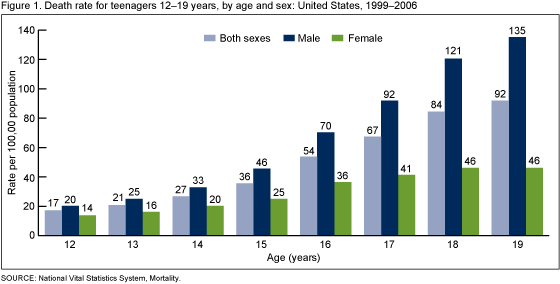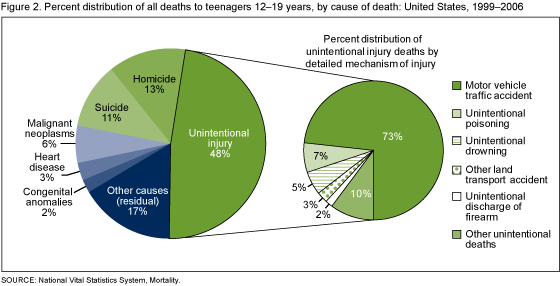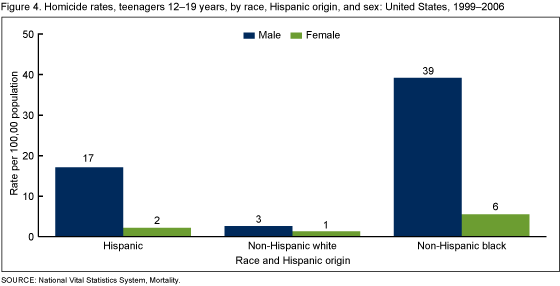Mortality Among Teenagers Aged 12-19 Years: United States, 1999-2006
NCHS Data Brief No. 37, May 2010
On this Page
- Key findings
- What is the risk of dying for teenagers 12-19 years?
- What are the leading causes of death for teenagers?
- Does teenage mortality vary by race, sex, and Hispanic origin?
- What cause of death accounts for the high death rates among non-Hispanic black male teenagers?
- Summary
- Definitions
- Data source and methods
- About the author
- References
- Suggested citation
PDF Version (871 KB)
Arialdi M. Miniño, M.P.H.
Key findings
Data from the National Vital Statistics System-Mortality
- An average of 16,375 teenagers 12-19 years died in the United States every year from 1999 to 2006. This is less than 1 percent of all deaths that occur every year in the United States.
- The five leading causes of death among teenagers are Accidents (unintentional injuries), homicide, suicide, cancer, and heart disease. Accidents account for nearly one-half of all teenage deaths.
- As a category of accidents, motor vehicle fatality is the leading cause of death to teenagers, representing over one-third of all deaths.
- Among teenagers, non-Hispanic black males have the highest death rate (94.1 deaths per 100,000 population).
- Homicide is the leading cause of death for non-Hispanic black male teenagers. For all other groups, accident is the leading cause.
Deaths to teenagers 12-19 years comprise a small fraction of the total deaths occurring each year in the United States. From 1999 to 2006 less than 1 percent (0.68 percent)--or 131,000 deaths--occurred to teenagers 12-19 years. This represents an average of 16,375 deaths per year for this group. Teenage mortality is an important public health issue because the majority of deaths among teenagers are caused by external causes of injury such as accidents, homicide, and suicide. These causes of death are, by definition, preventable.
Keywords: Death, children, National Vital Statistics System
What is the risk of dying for teenagers 12-19 years?
Each year from 1999 to 2006, the annual death rate for teenagers has averaged 49.5 deaths per 100,000 population. However, the risk of dying is not distributed evenly among all teenagers. Male teenagers are more likely to die than female teenagers at every single year of age from 12 to 19 years, and older teenagers are at higher risk of dying than younger teenagers. At age 12, for example, the death rate for males (20.2 deaths per 100,000) is 46 percent higher than the rate for females (13.8 deaths per 100,000). At age 19 the death rate for males (135.2 deaths per 100,000) is almost three times the rate for females (46.1 deaths per 100,000).
Among teenagers 12-19 years, death rates increase with every additional year of age. This pattern is stronger for males. Starting at age 12 and ending at 19 years, the death rate among teenage males increases 32 percent on average for every additional year of age. For females, on the other hand, the death rate increases on average 19.5 percent for every additional year of age (Figure 1).
What are the leading causes of death for teenagers?
The leading causes of death for the teenage population remained constant throughout the period 1999-2006: Accidents (unintentional injuries) (48 percent of deaths), homicide (13 percent), suicide (11 percent), cancer (6 percent), and heart disease (3 percent). Motor vehicle accident accounted for almost three quarters (73 percent) of all deaths from unintentional injury (Figure 2).
Does teenage mortality vary by race, sex, and Hispanic origin?
The death rate for teenagers 12-19 years varies by sex, race, and Hispanic origin. Non-Hispanic black teenagers are 37 percent more likely to die than Hispanic and non-Hispanic white teenagers. The death rate for non-Hispanic black teenagers is 64.5 deaths per 100,000 population compared with 47.1 for Hispanic and 47.0 for non-Hispanic white teenagers (Figure 3). Among male and female teenagers, the death rate for non-Hispanic black male teenagers is the highest. The death rate for non-Hispanic black male teenagers is 94.1 deaths per 100,000 population.
What cause of death accounts for the high death rates among non-Hispanic black male teenagers?
Non-Hispanic black male teenagers are disproportionately affected by homicide. Homicide is the leading cause of death for non-Hispanic black male teenagers. The risk of dying from homicide among non-Hispanic black male teenagers (39.2 per 100,000 population) is more than twice that of Hispanic males (17.1 per 100,000 population) (Figure 4) and about 15 times that of non-Hispanic white males (2.6 per 100,000 population).
Summary
From 1999 to 2006, an average of 16,375 teenagers 12-19 years died each year. The overall risk of dying for teenagers (average annual death rate) is 49.5 deaths per 100,000 population. Accidents (unintentional injuries), homicide, suicide, cancer, and heart disease make up the five leading causes of death for teenagers. Motor vehicle fatality is the leading cause of accident death among teenagers, representing over one-third of all deaths to teenagers. Non-Hispanic black teenage males have the highest death rate compared with Hispanic and non-Hispanic white males and females. Homicide is the leading cause of death for non-Hispanic black male teenagers, with more than two of every five deaths due to homicide.
Definitions
Death rate: A measure of the individual risk of dying within a given population. It is defined as the ratio of the number of deaths counted for a given population and within a given time period divided by the point estimate of the population at risk of dying. Denominator data necessary for computation of death rates are provided by the U.S. Census Bureau under a collaborative agreement with NCHS (1,2). Death rates are reported per 100,000 population.
Causes of death: Medical information (including injury diagnoses and external causes of injury) entered on death certificates that are filed in the United States is classified and coded in accordance with the International Statistical Classification of Diseases and Related Health Problems Tenth Revision (ICD-10). For more information about the underlying cause of death, the ICD and other related concepts see the “Technical Notes” of the corresponding yearly final reports on mor-tality in the United States (3-10).
Hispanic origin and race: Race and Hispanic origin are reported separately on the death certificate. In this report, tables or charts showing deaths by Hispanic origin and race combine the separate variables into three nonoverlapping groups: Hispanic, non-Hispanic white, and non-Hispanic black. Because of their relatively small numbers, groups of other ethnic origins and races outside of these three groups are not considered when analyzing differences by origin and race. For more information about reporting of Hispanic origin and race on the death certificate, see the “Technical Notes” of the corresponding yearly final reports on mortality in the United States (3-10).
Data source and methods
Data are from the public-use Multiple Cause of Death files from the National Vital Statistics System for years 1999-2006. For this report only decedents aged 12-19 years were studied, and combined data for years 1999-2006 were analyzed together. Differences between rates and percentages were evaluated using two-sided significance tests at the 0.05 level. Terms such as “higher than” and “less than” indicate statistically significant differences. Trends of increasing risk of death with increase in age were statistically evaluated using Spearman’s (nonparametric, rho) correlation coefficient. Lack of comment regarding the difference between any two statistics does not necessarily suggest that the difference was tested and found to not be statistically significant.
About the author
Arialdi Miniño is a statistician at the Centers for Disease Control and Prevention’s National Center for Health Statistics, Division of Vital Statistics, Mortality Statistics Branch.
References
- National Center for Health Statistics. Vintage 2007 bridged-race postcensal population estimates for calculating vital rates; resident population of the United States for 2000-2007, by county, single-year of age (0, 1, 2, ..., 85 years and over), bridged race (White, Black or African American, American Indian or Alaska Native, Asian or Pacific Islander), Hispanic origin (not Hispanic or Latino, Hispanic or Latino), and sex. (Vintage 2007) File pcen_v2007_y06.txt (ASCII).
- National Center for Health Statistics. Bridged-race 1990-1999 intercensal population estimates (single-year of age detail) for calculating vital rates; resident population of the United States by year, single-year of age (0,1,2,…, 85 years and over), bridged race (White, Black or African American, American Indian or Alaska Native, Asian or Pacific Islander), Hispanic origin (not Hispanic or Latino, Hispanic or Latino), and sex. File icen_natA1.txt (ASCII).
- Heron MP, Hoyert DL, Murphy SL, Xu JQ, Kochanek KD, Tejada-Vera B. Deaths: Final data for 2006. National vital statistics reports; vol 57 no 14. Hyattsville, MD: National Center for Health Statistics. 2009.
- Kung HC, Hoyert DL, Xu JQ, Murphy SL. Deaths: Final data for 2005. National vital statistics reports; vol 56 no 10. Hyattsville, MD: National Center for Health Statistics. 2008.
- Miniño AM, Heron MP, Murphy SL, Kochankek, KD. Deaths: Final data for 2004. National vital statistics re-ports; vol 55 no 19. Hyattsville, MD: National Center for Health Statistics. 2007.
- Hoyert DL, Heron MP, Murphy SL, Kung H. Deaths: Final data for 2003. National vital statistics reports; vol 54 no 13. Hyattsville, MD: National Center for Health Statistics. 2006.
- Kochanek KD, Murphy SL, Anderson RN, Scott C. Deaths: Final data for 2002. National vital statistics reports; vol 53 no 5. Hyattsville, MD: National Center for Health Statistics. 2004.
- Arias E, Anderson RN, Hsiang-Ching K, Murphy SL, Kochanek KD. Deaths: Final data for 2001. National vital statistics reports; vol 52 no 3. Hyattsville, MD: National Center for Health Statistics. 2003.
- Miniño AM, Arias E, Kochanek KD, Murphy SL, Smith BL. Deaths: Final data for 2000. National vital statistics reports; vol 50 no 15. Hyattsville, MD: National Center for Health Statistics. 2002.
- Hoyert DL, Arias E, Smith BL, Murphy SL, Kochanek KD. Deaths: Final data for 1999. National vital statistics reports; vol 49 no 8. Hyattsville, MD: National Center for Health Statistics. 2001.
Suggested citation
Miniño AM. Mortality among teenagers aged 12-19 years: United States, 1999-2006. NCHS data brief, no 37. Hyattsville, MD: National Center for Health Statistics. 2010.
Copyright information
All material appearing in this report is in the public domain and may be reproduced or copied without permission; citation as to source, however, is appreciated.
National Center for Health Statistics
Edward J. Sondik, Ph.D., Director
Jennifer H. Madans, Ph.D., Associate Director for Science
Division of Vital Statistics
Charles J. Rothwell, M.S., Director
- Page last reviewed: November 6, 2015
- Page last updated: May 5, 2010
- Content source:


 ShareCompartir
ShareCompartir



